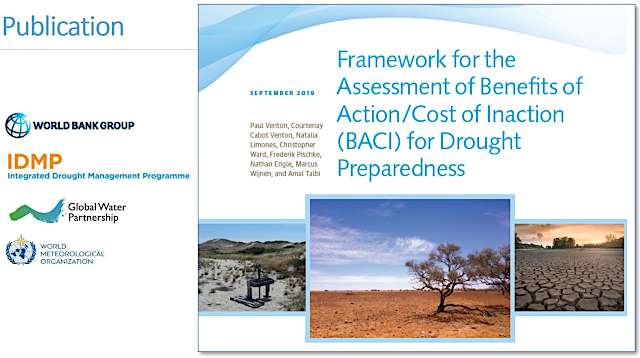The Drought Preparedness Day is an occasion to present and discuss the successes and challenges of current tools, methodologies and policies supporting drought preparedness. GWP was a co-organizer of the day and was speaking at several sessions.
Throughout the day, the achievements of the UNCCD Drought Initiative were showcased, as well as the important partnerships and frameworks such as the Global Framework on Water Scarcity in Agriculture (WASAG), the Integrated Drought Management Programme (IDMP) and the UN-Water.
Assessing the BACI
In introducing the GWP/WMO/World Bank working paper Frederik Pischke, Senior Network Specialist of GWP explained that we need to “address the paradox if proactive drought risk management is socially and economically optimal compared with reactive crisis management, why is the shift from crisis to risk management for droughts happening so slowly? By helping practitioners make the economic case, the working paper provides a methodological framework to support this shift in practice.”
The objective is to set out a framework to assess the BACI for drought mitigation and preparedness. It builds on the work accomplished under the collaboration between the joint GWP/WMO Integrated Drought Management Programme (IDMP) and the World Bank, while also drawing on best practices from other agencies and related work streams. The paper emphasizes that there is an initial need for a conceptual framework for analyzing the BACI and argues that the framework should be systematic enough to allow for comparability across countries and contexts, with the option of being tailored as needed.
The document is a guide to those responsible for drought management to support them in making the economic case for integrated drought risk management. Its main audience is development practitioners, who are engaged with governments and are often the ones advocating for more proactive drought preparedness.
All-of-society engagement needed
Speaking at the launch event, GWP Chair Howard Bamsey said that “to protect and support the vulnerable, we will need an all-of-society engagement – with political leadership, solid science informing policy, an emphasis on the gender dimension, and finance coming together. Multi-stakeholder platforms have an important role to play here, ensuring that inequality does not get exacerbated and that political will can be turned into effective action.”
At the same event, GWP’s new Strategy for 2020-2025 – Mobilising for a Water Secure World – was also introduced. One of the strategy’s strategic goals is to catalyse Climate Resilient Development with drought (and flood) management as a key component. More information on GWP’s involvement in the UNCCD COP14.

